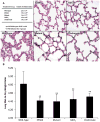Role of Kupffer cells and toll-like receptor 4 in acetaminophen-induced acute liver failure
- PMID: 23260383
- PMCID: PMC3578072
- DOI: 10.1016/j.jss.2012.11.051
Role of Kupffer cells and toll-like receptor 4 in acetaminophen-induced acute liver failure
Abstract
Background: Significant morbidity associated with acute liver failure (ALF) is from the systemic inflammatory response syndrome (SIRS). Toll-like receptor 4 (TLR4) has been shown to play an integral role in the modulation of SIRS. However, little is known about the mechanistic role of TLR4 in ALF. Also, no cell type has been identified as the key mediator of the TLR4 pathway in ALF. This study examines the role of TLR4 and Kupffer cells (KCs) in the development of the SIRS following acetaminophen (APAP)-induced ALF.
Materials and methods: Five groups of mice were established: untreated wild-type, E5564-treated (a TLR4 antagonist), gadolinium chloride -treated (KC-depleted), clodronate-treated (KC-depleted), and TLR4-mutant. Following APAP administration, 72-h survival, biochemical and histologic liver injury, extent of lung injury and edema, and proinflammatory gene expression were studied. Additionally, TLR4 expression was determined in livers of wild-type and KC-depleted mice.
Results: Following APAP administration, wild-type, TLR4-mutant, E5564-treated, and KC-depleted mice had significant liver injury. However, wild-type mice had markedly worse survival compared with the other four treatment groups. TLR4-mutant, E5564-treated, and KC-depleted mice had less lung inflammation and edema than wild-type mice. Selected proinflammatory gene expression (interleukin 1β, interleukin 6, tumor necrosis factor) in TLR4-mutant, E5564-treated, and KC-depleted mice was significantly lower compared with wild-type mice after acute liver injury.
Conclusion: This study demonstrates that survival in APAP-induced ALF potentially correlates with the level of proinflammatory gene expression. This study points to a link between TLR4 and KCs in the APAP model of ALF and, more importantly, demonstrates benefits of TLR4 antagonism in ALF.
Copyright © 2013 Elsevier Inc. All rights reserved.
Conflict of interest statement
Disclosures: No disclosures for any authors. No conflict of interests for any authors.
Figures




References
-
- Rolando N, Wade J, Davalos M, Wendon J, Philpott-Howard J, Williams R. The systemic inflammatory response syndrome in acute liver failure. Hepatology. 2000;32:734–739. - PubMed
-
- Vaquero J, Polson J, Chung C, Helenowski I, Schiodt FV, Reisch J, Lee WM, Blei AT. Infection and the progression of hepatic encephalopathy in acute liver failure. Gastroenterology. 2003;125:755–764. - PubMed
-
- Galun E, Axelrod JH. The role of cytokines in liver failure and regeneration: potential new molecular therapies. Biochim Biophys Acta. 2002;1592:345–358. - PubMed
Publication types
MeSH terms
Substances
Grants and funding
LinkOut - more resources
Full Text Sources
Other Literature Sources
Medical

